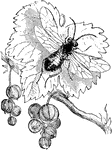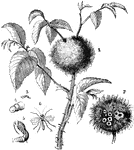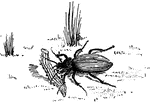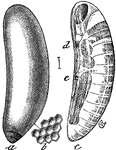
Puss Moth
The Puss Moth (Cerura vinula) is a lepidoptera from the family Notodontidae. The puss moth is stinging…

Various Stages of a Carpet Beetle
"Figure 9- Anthrenus scrofulariae, enlarged; the short line shows natural size. a, b, larvae; c, pupa;…
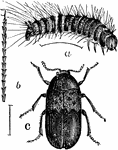
Larder Beetle Larvae and Imago
"Figure 10- Dermestes lardarius (Larder beetle) enlarged. a, larva; b, an enlarged hair; c, imago."…

Brown Beetle
"Figure 11- Sitodrepa panicea enlarged. a, imago; b, its antenna, more enlarged" Elliot Coues, 1884
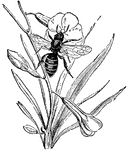
Bee Pollinating a Flower
"Bee, the common name given to a large family of hymenopterous or membranous-winged insects, of which…

Praying Mantis
Mantodea or mantises is an order of insects which contains approximately 2,200 species in 9 families…

Ox Botfly
"Ox Botfly. a.-- larva, full grown, natural size; b,-- pupa; c.-- perfect insect. Botfly, Gadfly, and…
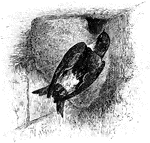
House Martin
The House Martin (Delichon urbicum), sometimes called the Northern House Martin or Common House Martin,…
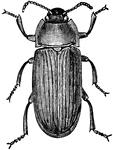
Mealworm Beetle
Mealworms are the larva form of the mealworm beetle, Tenebrio molitor, a species of darkling beetle.…
Mealworm Larva
Mealworms are the larva form of the mealworm beetle, Tenebrio molitor, a species of darkling beetle.…
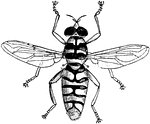
Hoverfly
Flies in the family Syrphidae are commonly known as hoverflies, flower flies, or syrphid flies.As their…

Virgil Solis Print
This is a print that is part of an illustrated Bible that was created by German printmaker Virgil Solis…
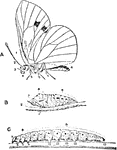
Three Stages of Cabbage Buterfly
A sequenced illustration of the cabbage butterfly undergoing metamorphosis. The butterfly starts out…
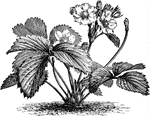
Strawberry Plant
An image of a strawberry plant in flower. There are numerous short Stamens that are readily accessible…
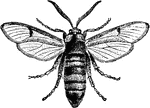
Hornet Moth
Also known as Sesia apiformis. A large moth with a striking imitation of a hornet. They are, however,…
!["The larvae of [Saperda populena] live in gall-like swellings in the branches [of poplar]."—Nicholson, 1884](https://etc.usf.edu/clipart/79000/79089/79089_populena_mth.gif)
Saperda Populena
"The larvae of [Saperda populena] live in gall-like swellings in the branches [of poplar]."—Nicholson,…

Potato Beetle
Also known as Doryphora decemlineata. It is approximately 10 millimeters in length, with a bright yellow…
!["The [potato beetle larva] is pale yellow, or, rather, dusky-yellow, or freckled with minute black dots on the back; and there are two rows of larger black dots along each side; the legs are black."—Nicholson, 1884](https://etc.usf.edu/clipart/79000/79099/79099_potatolarva_mth.gif)
Larva of Potato Beetle
"The [potato beetle larva] is pale yellow, or, rather, dusky-yellow, or freckled with minute black dots…

Large White Cabbage Butterfly
Also known as Pieris brassicae. It is commonly found throughout Europe, Asia, and north Africa. The…

Larva and Pupa of a Large White Cabbage Butterfly
Also known as Pieris brassicae. An image of the larva and pupa of the large white cabbage butterfly.

Larvae of Rose Sawfly
A parasite which feeds as larvae in rose-twigs or upon the leaves. Some species are confined to roses…
Fountain Pump
A tool used in washing the dust off plants. It can also wash the eggs of insects off the leaves before…

Snowy Tree Cricket
A tree cricket that lives in trees and shrubs. They feed on plant parts, other insects, and fungi.
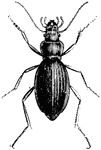
Common Garden Beetle
Beetles are one of the most extensive orders of insects. The beetle is recognized by its front wings…

Devil's Coach Horse
This insect can be beneficial to gardens. This insect eats other insects and snails.

Grub of Ladybird
The grub of the beneficial ladybird. This insect is beneficial to gardens because it eats aphides.
The Bean Fly
The bean fly is found on many herbaceous plants. This fly is harmful to beans but is not easy to exterminate.

Female Gipsy Moth
The female gipsy moth is larger than the male. The wings are a dingy or yellowish white with darker…

Gooseberry or Magpie Moth
The Gooseberry or Magpie moth is often mistaken for a butterfly. The moth usually appears in the middle…

Ichneumon Fly
Ichneumon flies have slender bodies, veined wings with the veins enclosing several spaces or cells,…

Larva of a Ladybird
Ladybirds and their larva are beneficial to gardens because they eat other insects as food.

Ichneumon Fly
Ichneumon flies deposit their eggs upon the bodies of other insects and larva. The larva live on the…

Common Ground Beetle
The common ground beetle feeds mostly on insects, though some of them are partly vegetarian.
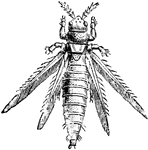
Magnified Thrips
Thrips are very small insects that live in flowers. Thrips gnaw the surface of petals.

Larva, Frothy Section, and Perfect Insect of the Frog Hopper
Frog hoppers belong to the order Heteroptera. This order is also known as plant bugs. These insects…
Millipede
Millipedes are usually cylindrical. The origins of the legs are usually brought very close to the middle…

Oak Galls
Galls are structures budded out from stems, leaves, or other pats of plants. Galls are made by insects…
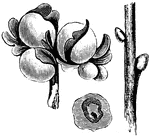
Oak Galls
Galls are structures budded out from stems, leaves, or other pats of plants. Galls are made by insects…
Insect Life Stages
Illustrated are the four stages in an insects' life: egg, larva, pupa, imago. The insect pictured is…

Spreading Board Section
Illustrated is the cross section of a spreading board used for drying soft winged insects.

Locust Anatomy
Enlarged end of the female, showing oviposition: the oviduct, the egg guide, and the egg issuing from…

The Flory-Locust Machine
The Flory-locust machine was a horse-drawn implement used by farmers to exterminate locust populations.…

Galeopithecus
Galeopithecus is the generic name of certain mammals from the Malayan region, commonly (incorrectly)…
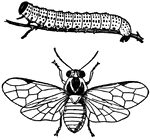
Gooseberry Caterpillar (Nematus ribesii) and Sawfly
Gooseberry Caterpillar is the name applied to the larvæ of two different insects, both injurious to…
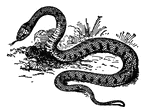
Grass Snake
Its color is olive-gray or brown above, with black bands and spots, and checkered black and white beneath.…
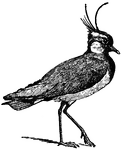
Lapwing (or Peewit)
A handsome plover-like bird of Northern Europe and Asia (Vanellus cristatus), also known in Great Britain…
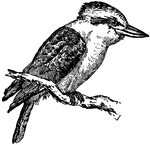
Kingfisher, Dacelo gigas
The Settler's Clock ('Dacelo gigs'), is a very large kingfisher found in Australia, where it receives…
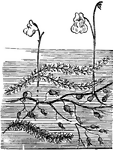
Bladderwort
This illustration shows a Bladderwort, some of whose leaves have converted into traps for insects.






